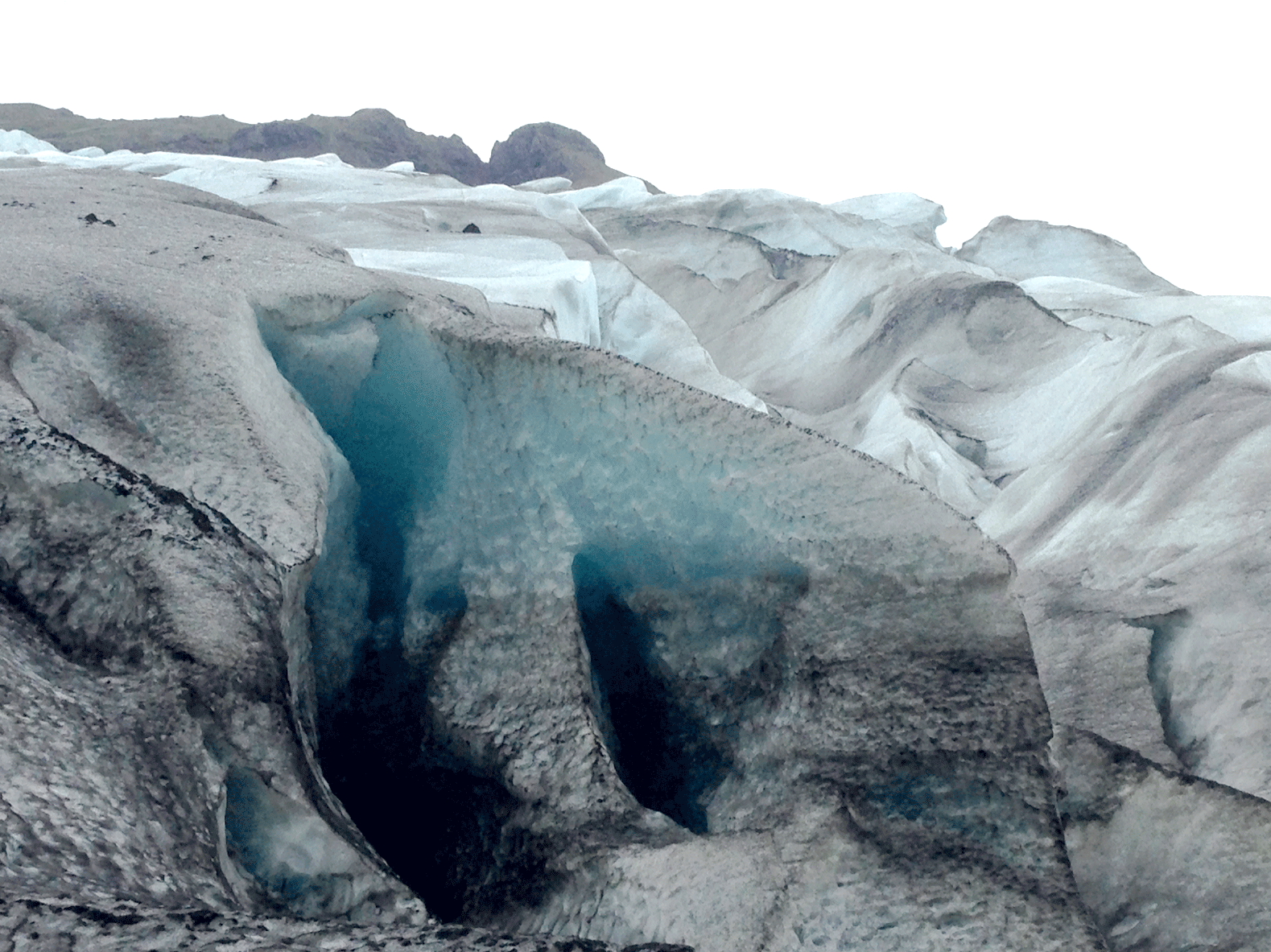See ➝.
J. T. Houghton, Y. Ding, D. J. Griggs, M. Noguer, P. J. Van der Linden, X. Dai, K. Maskell, and C. A. Johnson, “Climate Change 2001: The Scientific Basis, summary for policy makers—contribution of working group I to the third assessment report of the Intergovermental Panel on Climate Change.” (Cambridge: University of Cambridge Press, 2001).
The 2017 Arctic Monitoring and Assessment Programme report detailed that global sea levels will rise much more quickly than previously thought; the new estimates are almost double the pace predicted by the IPCC in 2013. ➝.
Timothy Morton, Hyperobjects: Philosophy and Ecology after the End of the World (Minneapolis: University of Minnesota Press, 2013), 161.
By definition, glaciers are formed where winter snowfall accumulation exceeds that of summer melting or calving, allowing snow to amass on the surface and eventually become ice. Critical thickness for glacier formation is approximately 30 meters with a density of 0.85 g/cm3. When these conditions are achieved, the existing ice deforms and moves downslope to become a glacier. Iceland is dominated by six primary glaciers. See Ingólfur Ásgeir Jóhannesson, “Icelandic Nationalism and the Kyoto Protocol: An Analysis of the Discourse on Global Environmental Change in Iceland.” Environmental Politics 14(4) (2005): 495-509.
See Cheryl Katz, “What is Iceland Without Ice?,” Scientific American, December 18, 2013. Nearly half of the world’s terrestrial glaciers are located in the Arctic region.
See Rasmus Gjedssø Bertelsen and Piotr Graczyk, “Establishing Shared Knowledge about Globalization in Asia and the Arctic,” Cultural Anthropology, July 29, 2016, ➝; and Diplomacy on Ice: Energy and the Environment in the Arctic and Antarctic, eds. Rebecca Pincus and Saleem H. Ali (New Haven: Yale University Press, 2015).
See Mark Nuttall, “Subsurface Politics: Greenlandic Discourses on Extractive Industries,” in Handbook of the Politics of the Arctic, eds. Leif Christian Jensen and Geir Hønneland (Cheltenham: Edward Elgar, 2015): 105–127; and Mark Nuttall, “The Making of Resource Spaces in Greenland,” Cultural Anthropology, July 29, 2016. ➝.
Formerly called the Northeast Passage, the Northern Sea Route traverses the Eastern Arctic seas and connects the Atlantic and Pacific oceans. In the past it has been free of sea ice only two months out of the year. Seasonal variation in the Artic is considered to be more extreme than anywhere else on earth, moving from ice-cover to lush conditions in annual cycles. The Arctic Ocean, surrounded as it is by land, is more subject to terrestrial influence than any other ocean on the planet; its hydrology is singular, on the one hand encircled by land and on the other, fed by some of the world’s largest rivers. See National Research Council, The Arctic in the Anthropocene: Emerging Research Questions (Washington DC: The National Academies Press, 2014).
We intentionally adopt the oceanographic term “world ocean” to emphasize that this is a continuous body of water encircling the Earth, with relatively uninhibited interchange and transference across the world hydrosphere. Human designations of “the {Atlantic, Pacific, Southern, etc.} ocean” or “sea” may be useful geographic markers for human-imagined demarcations, but the Earth’s fluid envelope is not similarly bounded.
➝.
Scientists have demonstrated that terrestrial ice melting into the ocean creates a non-uniform pattern of regional sea level rise which can be tracked using “sea level fingerprints.” Recently, it has been shown that ocean station measurements of sea level fingerprints correspond with that calculated from satellite measurements, which are able to determine ocean mass changes over time in local settings, accounting for gravitational fluctuation. See Chia-Wei Hsu and Isabella Velicogna, “Detection of sea level fingerprints derived from GRACE gravity data,” Geophysical Research Letters 44, 17 (2017): 8953–8961.
➝. See also Eric Larour, Erik R. Ivins, and Surendra Adhikari “Should coastal planners have concern over where land ice is melting?” Science Advances 3, 11 (November 15 2017).
➝. A joint effort by NASA and the Deutsche Forschungsanstalt für Luft und Raumfahrt (DLR) in Germany, GRACE (Gravity Recovery and Climate Experiment) satellites, launched in 2002, are now operating under “an extended mission” phase. GRACE is comprised of two spacecraft, 220 kilometers apart in a polar orbit, 500 kilometers above Earth. The objective of GRACE is to map the Earth’s gravitational field by accurately measuring the distance between the two satellites, using GPS and microwave signals. GRACE satellites have provided data on: changes due to surface and deep currents in the ocean; runoff and ground water storage on land masses; exchanges between ice sheets or glaciers and the ocean; and variations of mass within Earth. GRACE is also being utilized to better profile Earth's atmosphere, and the project overall is seen to be making very significant contributions to NASA's Science Mission Directorate, Earth Observation System (EOS) and global climate change studies. P. Wessel, and W. H. F. Smith, “A Global Self-consistent, Hierarchical, High-resolution Shoreline Database,” Journal of Geophysical Research 101, #B4 (1996): 8741–8743; and Michael M. Watkins, David N. Wiese, Dah-Ning Yuan, Carmen Boening, and Felix W. Landerer, “Improved methods for observing Earth's time variable mass distribution with GRACE using spherical cap mascons,” Journal of Geophysical Research 120, 4 (2015): 2648–2671.
Franck Billé “Introduction: Speaking Volumes,” Cultural Anthropology, October 24, 2017, ➝.
See Timothy Mitchell, Carbon Democracy: Political Power in the Age of Oil (London: Verso, 2011). And Stacey Alaimo Exposed: Environmental Politics and Pleasures in Posthuman Times (Minneapolis: University of Minnesota Press, 2016).
